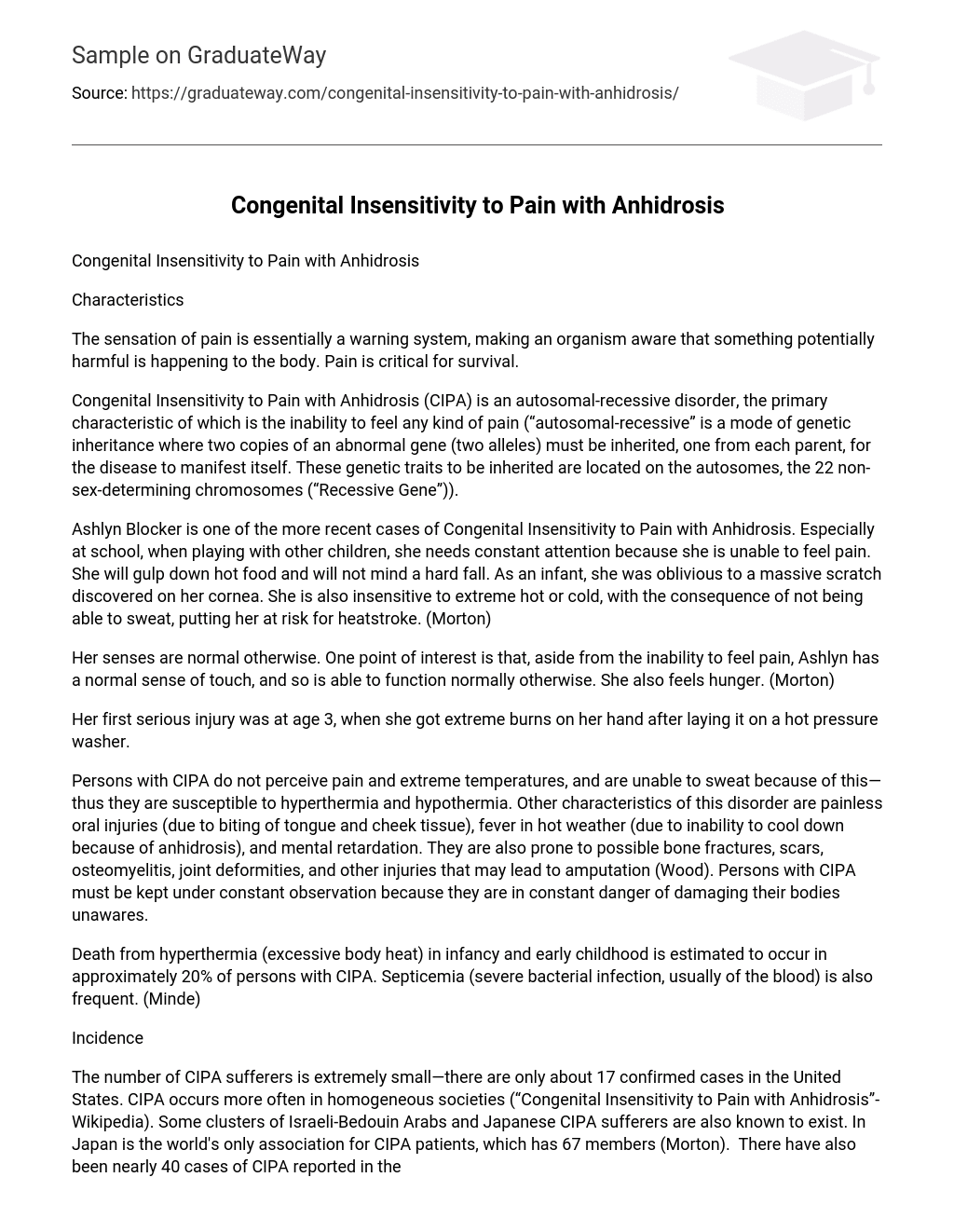Characteristics
The sensation of pain is essentially a warning system, making an organism aware that something potentially harmful is happening to the body. Pain is critical for survival.
Congenital Insensitivity to Pain with Anhidrosis (CIPA) is an autosomal-recessive disorder, the primary characteristic of which is the inability to feel any kind of pain (“autosomal-recessive” is a mode of genetic inheritance where two copies of an abnormal gene (two alleles) must be inherited, one from each parent, for the disease to manifest itself. These genetic traits to be inherited are located on the autosomes, the 22 non-sex-determining chromosomes (“Recessive Gene”)).
Ashlyn Blocker is one of the more recent cases of Congenital Insensitivity to Pain with Anhidrosis. Especially at school, when playing with other children, she needs constant attention because she is unable to feel pain. She will gulp down hot food and will not mind a hard fall. As an infant, she was oblivious to a massive scratch discovered on her cornea. She is also insensitive to extreme hot or cold, with the consequence of not being able to sweat, putting her at risk for heatstroke. (Morton)
Her senses are normal otherwise. One point of interest is that, aside from the inability to feel pain, Ashlyn has a normal sense of touch, and so is able to function normally otherwise. She also feels hunger. (Morton)
Her first serious injury was at age 3, when she got extreme burns on her hand after laying it on a hot pressure washer.
Persons with CIPA do not perceive pain and extreme temperatures, and are unable to sweat because of this—thus they are susceptible to hyperthermia and hypothermia. Other characteristics of this disorder are painless oral injuries (due to biting of tongue and cheek tissue), fever in hot weather (due to inability to cool down because of anhidrosis), and mental retardation. They are also prone to possible bone fractures, scars, osteomyelitis, joint deformities, and other injuries that may lead to amputation (Wood). Persons with CIPA must be kept under constant observation because they are in constant danger of damaging their bodies unawares.
Death from hyperthermia (excessive body heat) in infancy and early childhood is estimated to occur in approximately 20% of persons with CIPA. Septicemia (severe bacterial infection, usually of the blood) is also frequent. (Minde)
Incidence
The number of CIPA sufferers is extremely small—there are only about 17 confirmed cases in the United States. CIPA occurs more often in homogeneous societies (“Congenital Insensitivity to Pain with Anhidrosis”-Wikipedia). Some clusters of Israeli-Bedouin Arabs and Japanese CIPA sufferers are also known to exist. In Japan is the world’s only association for CIPA patients, which has 67 members (Morton). There have also been nearly 40 cases of CIPA reported in the Swedish city of Gällivare (“Congenital Insensitivity to Pain with Anhidrosis”-Wikipedia).
Cause
CIPA is caused by a rare genetic mutation that prevents the formation of nerve cells which are responsible for delivering pain, heat, and cold sensations to the spinal cord and the brain (“Congenital Insensitivity to Pain with Anhidrosis”-Wikipedia). The inability to feel pain is due to the absence of unmyelinated nerve fibers and reduced numbers of small myelinated (electrically insulated by myelin, a phospholipid layer that surrounds the axons of many neurons) fibers that carry pain-invoking impulses to the spinal cord and the brain when tissue is damaged (Alabousi). The anhidrosis is caused by a lack of nerves in eccrine sweat glands, which play a significant role in body temperature regulation (Alabousi).
Specifically, CIPA is caused by a mutation in the TRKA gene, which is responsible for the production of the TRKA protein, a receptor tyrosine kinase (RTK) for nerve growth factor (NGF), which is necessary for survival of nociceptive (pain-inducing) sensory neurons (Minde). The mutation causes production of defective TRKA proteins, which causes abnormalities in the NGF signal transduction path.
In normal individuals, Nerve Growth Factor (NGF) stimulates the growth of nociceptive sensory neurons, which transmit pain sensations to the spinal cord and the brain. NGF also functions as a signal for the suppression of apoptosis (programmed cell death) in nociceptive sensory neurons. (Alabousi)
The TRKA protein has a high affinity for NGF, and is activated by NGF. It phosphorylates (adds a phosphate group to) itself in response to the NGF released from the target cells. NGF is then internalized into the neuron (“Nerve Growth Factor”). The self-phosphorylation of TRKA results in various paths of signal transduction (the movement of signals from outside to inside a cell) between nerve cells. The NGF/TrkA complex is then brought back to the cell body, which in turns results in survival and maintainance of nociceptive sensory neurons (neurons responsible for pain reception). Nociceptive neurons die when NGF is not transduced into them. (Alabousi) (Researchers at the University of Florida at Gainesville have discovered that wounds bathed in NGF healed twice as fast as untreated and unlicked wounds. NGF is found in the saliva of mice. NGF has not been found in human saliva (“Nerve Growth Factor”).
There are at least 37 different TRKA mutations that have been identified in persons who suffer from CIPA (Alabousi).
There is currently no treatment available for CIPA; only supportive therapy is performed.
References
Recessive gene. 5 April 2006. Wikipedia. Wikimedia Foundation. 26 April 2006. ;http://en.wikipedia.org/wiki/Recessive;.
Morton, Stephen. 1Rare disease makes girl unable to feel pain. 1 Nov. 2004. MSNBC. 26 April 2006. ;http://www.msnbc.msn.com/id/6379795/;.
Wood, Courtney. Congenital Insensitivity to Pain with Anhidrosis. Washington State Universitiy. 26 April 2006. ;http://helium.vancouver.wsu.edu/~woodc/CIPA.html;.
Minde, Jan. “Norrbottnian congenital insensitivity to pain”. Acta Orthopaedica 77. Umea University. ;http://www.diva-portal.org/umu/abstract.xsql?dbid=746;.
Congenital Insensitivity to Pain with Anhidrosis. 26 April 2006. Wikipedia. Wikimedia Foundation.27 April 2006. ;http://en.wikipedia.org/wiki/Congenital_insensitivity_to_pain_with_anhidrosis;.
Alabousi, Abdullah. Congenital Insensitivity to Pain with Anhidrosis. (CIPA). 6 April 2005. McMaster Meducator. 26 April 2006. ;http://www.meducator.org/archive/20050406/06_cipa.html;
Nerve Growth Factor. 11 March 2006. Wikipedia. Wikimedia Foundation.26 April 2006. ;http://en.wikipedia.org/wiki/Nerve_growth_factor;.





